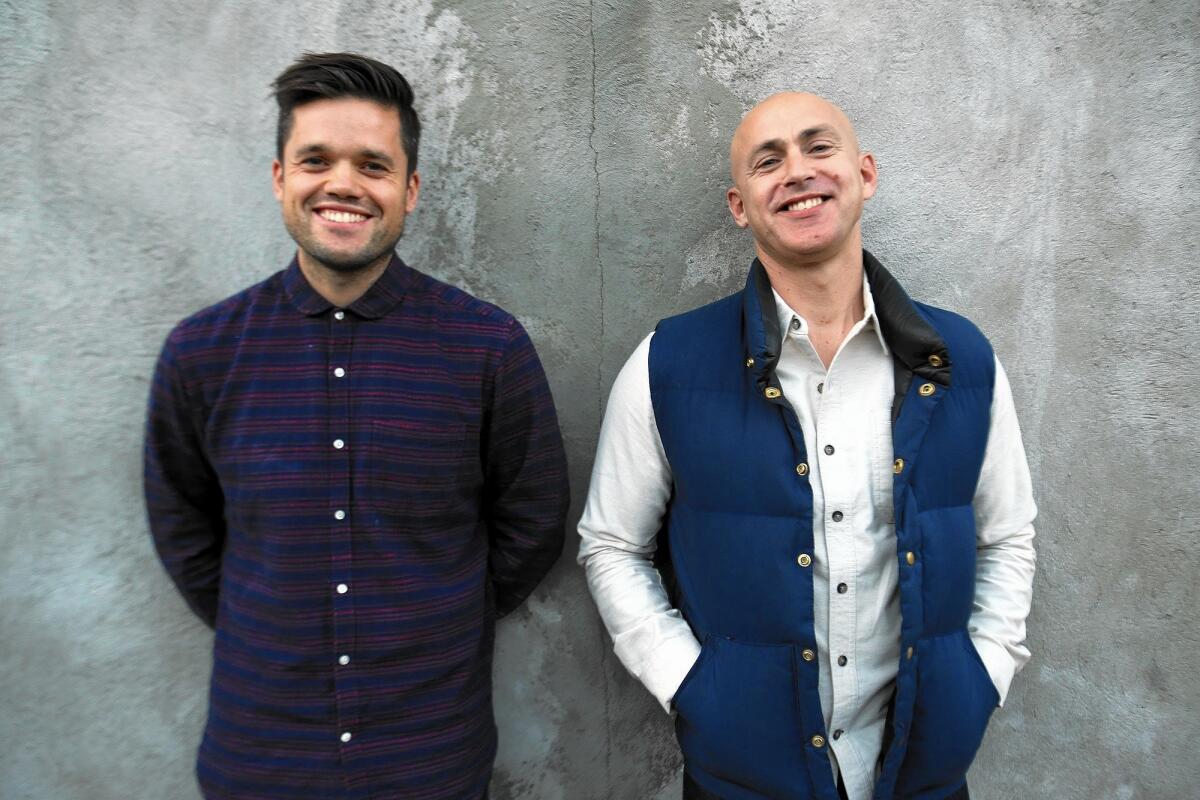Headspace app generates buzz as meditation turns ultra-trendy

Andy Puddicombe, a trained Buddhist monk, wants to spread health and happiness by teaching our technology-addled minds to slow down and live in the moment.
Naturally, he’s doing it through an app.
In just a few short minutes a day, users can listen to meditation guides for topics as varied as anxiety and relationships narrated by Puddicombe in his soothing British voice.
Join the conversation on Facebook >>
“This exercise isn’t about getting rid of thoughts, it’s more about learning how to be at ease with them,” he says assuringly in one of the 10-minute recordings.
Animations, videos and articles round out the experience — all in the pursuit of mindfulness, an increasingly fashionable discipline buoyed by technology that’s weaved its way through corporate America, Hollywood and Silicon Valley.
Headspace is now one of the most buzzed-about start-ups in where else but Venice, a neighborhood that evokes equal parts New Age hippie and Tesla-driving techie.
The company with the bite-sized path to enlightenment raised $30 million in September through the Chernin Group, a Los Angeles entertainment and media-focused investment firm.
Headspace also counts celebrities Jessica Alba, Jared Leto and Ryan Seacrest among its investors, not to mention Gwyneth Paltrow, Emma Watson and Zach Braff among its fans.
Part of the appeal is Headspace’s everyman accessibility. Puddicombe takes the chanting, incense and robes out of meditation. He and his business partner — fellow Brit and fellow surfer, Rich Pierson — like to stress they’re just regular “blokes.”
Meditation is for anyone, they say, and subscribing to Headspace should be no different than buying a gym membership for the mind.
“We go to the gym to be more active in life in just the same way we meditate; so we can be more mindful and more present and enjoy our life a little bit more,” said Puddicombe, 43, who is bald, athletically built and wouldn’t look out of place clad in a tracksuit coaching a pro soccer club.
Downloads of the app have quadrupled in the last 12 months to 5 million, though the company declined to say how many of those include paying subscribers with full access to the program.
SIGN UP for the free California Inc. business newsletter >>
Puddicombe has made the TED Talks circuit and appeared on CBS’ “This Morning” with Charlie Rose. His company was the subject of a 5,000-word profile in the New Yorker.
Virgin Atlantic offers Headspace in its in-flight entertainment. And employees at Google and LinkedIn have access to a companywide subscription.
“They’ve said it’s pop meditation,” Pierson said. “But if people actually use the product and they get into the content, they really understand how authentic it is.”
Headspace has resonated at a time when technology has leaped onto the mind health bandwagon — bolstered by the growing, but still small, body of science showing the benefits of meditation.
In addition to Headspace, there’s meditation apps such as Buddhify, Omvana, Smiling Mind and Dharma Seed.
One app, Insight Timer, offers guided meditations and recorded bell chimes.
“It goes off every 25 minutes to remind us to change our chant,” said Guru Jagat, who heads the Ra Ma Institute for Applied Yogic Science and Technology in Venice.
The closely followed yoga teacher with celebrity students posts some of her sessions on YouTube and is developing a meditation app of her own.
With these apps, you can lead a modern lifestyle and have fun and also be deeply spiritual, compassionate and calm. You don’t need to be in a cave in the Himalayas.
— Guru Jagat, who heads the Ra Ma Institute for Applied Yogic Science and Technology in Venice
“This is the future, of course,” said Jagat, 36, who has led meditations on cellphone addiction. “With these apps, you can lead a modern lifestyle and have fun and also be deeply spiritual, compassionate and calm. You don’t need to be in a cave in the Himalayas.”
Mindfulness apps like Headspace give people an edge, Jagat said, not only in their personal lives, but in hypercompetitive workplaces too.
“I definitely have Silicon Valley types around and everyone is using Headspace to meditate,” she said. “‘Mindful meditation’ is the buzzword and rage now that everyone is getting that Adderall can only get you so far. We all need more energy. We all need more focus.”
Melissa Sherman has used Headspace since August precisely to help her on the job. All it takes is listening to a few minutes with the earbuds on her train commute from Oakland to Redwood City.
“In some ways, it’s helped me become more aware in a stressful situation,” said Sherman, 43, a user experience architect at Pebble Tech. “It allows me to hunker down and focus through it.”
Cynthia MacKay, executive director of the Shambhala Meditation Center of Los Angeles, has been meditating for 26 years and has never seen the practice more trendy than it is today.
“Now everyone fancies his/herself a ‘meditator’ after listening to a four minute guided meditation app where someone talks in your ears the whole time,” she said in an email. “It seems the lineage has gone missing, the same way it did when yoga went for-profit. Is it still good? I think so.”
MacKay reasons it’s good because nothing is more effective reaching a wider audience than an app. She noticed it while teaching classes at Cliffside Malibu, the drug rehabilitation center for the well-to-do. Meditation apps were ensconced in many young people’s devices.
“The more ways there are to positively affect the mind, the better,” said MacKay, 49.
The longtime practitioner has even done her part for the digital meditation age. MacKay recently recorded guided meditations for “Your Daily Zen,” a show aimed at millennial women and moms on the digital network Awestruck.
Attitudes toward meditation weren’t nearly as welcoming when Puddicombe and Pierson launched Headspace in London in 2010.
“People thought we were completely bonkers when we first started doing this,” said Pierson, 35, who quit a career in advertising selling products like Axe deodorant and turned to meditation to address his severe anxiety.
“Back then we were like pariahs at parties,” he continued. “People would just back away. I still think there’s a bit of that weirdness going on.”
Puddicombe had come to meditation by way of early trauma in his life. At university, he witnessed friends die after being run over by a car. His stepsister died shortly afterward in a separate bicycle accident.
Deeply troubled, he decided to give up everything and train to become a monk. He spent 10 years studying Buddhism and meditation, partly in monasteries in India, Burma and Nepal.
When he returned to England, he found work at a clinic teaching meditation to ordinary professionals, many of whom had never considered the practice before.
He started prescribing hour-long meditations but found it was too much of a commitment. He reduced it to 30 minutes, but still patients found it too long.
“Eventually we tried 10 minutes and it made a difference,” Puddicombe said. “People’s lives are so frenetic, even just taking a short period of time out seems to have a really significant impact.”
After Pierson and Puddicombe were introduced by a mutual friend, the pair began hosting meditation events for hundreds in central London. Though well attended, the work was exhausting and difficult to scale up.
After some resistance, Puddicombe agreed to Pierson’s idea of starting an app, which he envisioned as like a Nike+ fitness tracker for meditation.
After a big marketing push in a British newspaper, Headspace earned a word-of-mouth following that was helped exponentially with each celebrity adherent. The company later shifted its headquarters to Venice.
Headspace is entering its next big phase, which coincides with its move 15 minutes away into a refurbished 20,000-square-foot warehouse next to Bergamot Station in Santa Monica this year.
On a recent weekday, Pierson was working in a Headspace office surrounded by whiteboard walls marked at the top with the heading “The Most Comprehensive Guide to Health and Happiness.”
Underneath was a road map for expansion to help more than double the company’s user base to 12 million in the next year. Headspace will offer dozens more meditations and expert talks on things like overeating, breakups and fear of death. They’re also developing a category for kids. Children as young as 4 are using Headspace.
The company is also expanding its offerings of animations, videos and shorter recordings lasting no more than a couple minutes. Ten minutes, it turns out, was still too long for many subscribers.
Until they developed the app, Puddicombe said he could never fathom reaching 5 million people.
“Not a chance,” he said, “never mind tens of millions we hope to reach. Without this, we simply wouldn’t be able to do what we do.
“I hope that over time that we will, as a society, move away from the idea that you have to do this thing for a long period of time, or wear certain clothes or talk in a certain way to benefit from this,” Puddicombe continued. “You don’t. You just have to sit down and close your eyes.”
Twitter: @dhpierson
ALSO
Apple shares falling as iPhone sales become a cause for concern
Lyft defies predictions by continuing to grow as a rival to Uber
RideAmigos app helps institutions manage their carpooling programs







